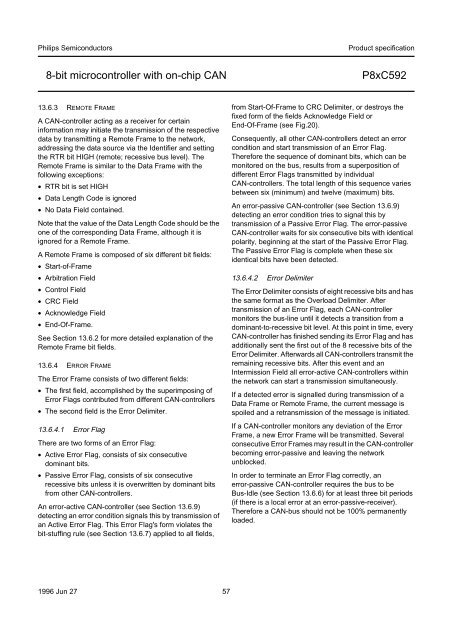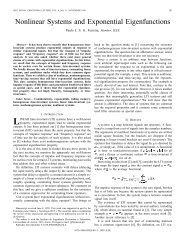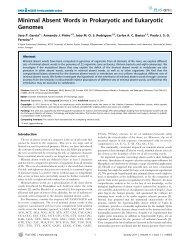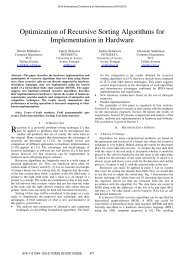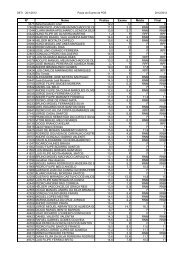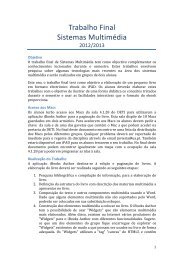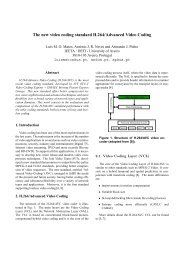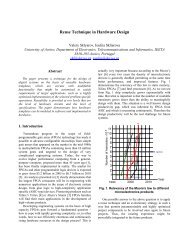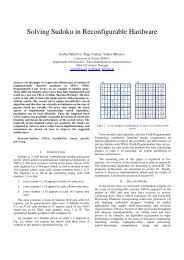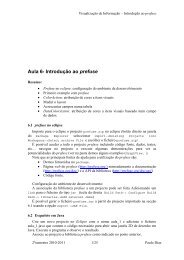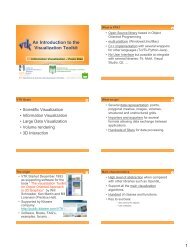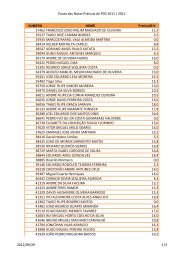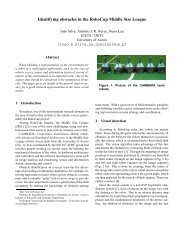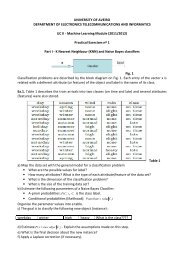DATA SHEET - IEETA
DATA SHEET - IEETA
DATA SHEET - IEETA
Create successful ePaper yourself
Turn your PDF publications into a flip-book with our unique Google optimized e-Paper software.
Philips Semiconductors Product specification<br />
8-bit microcontroller with on-chip CAN P8xC592<br />
13.6.3 REMOTE FRAME<br />
A CAN-controller acting as a receiver for certain<br />
information may initiate the transmission of the respective<br />
data by transmitting a Remote Frame to the network,<br />
addressing the data source via the Identifier and setting<br />
the RTR bit HIGH (remote; recessive bus level). The<br />
Remote Frame is similar to the Data Frame with the<br />
following exceptions:<br />
• RTR bit is set HIGH<br />
• Data Length Code is ignored<br />
• No Data Field contained.<br />
Note that the value of the Data Length Code should be the<br />
one of the corresponding Data Frame, although it is<br />
ignored for a Remote Frame.<br />
A Remote Frame is composed of six different bit fields:<br />
• Start-of-Frame<br />
• Arbitration Field<br />
• Control Field<br />
• CRC Field<br />
• Acknowledge Field<br />
• End-Of-Frame.<br />
See Section 13.6.2 for more detailed explanation of the<br />
Remote Frame bit fields.<br />
13.6.4 ERROR FRAME<br />
The Error Frame consists of two different fields:<br />
• The first field, accomplished by the superimposing of<br />
Error Flags contributed from different CAN-controllers<br />
• The second field is the Error Delimiter.<br />
13.6.4.1 Error Flag<br />
There are two forms of an Error Flag:<br />
• Active Error Flag, consists of six consecutive<br />
dominant bits.<br />
• Passive Error Flag, consists of six consecutive<br />
recessive bits unless it is overwritten by dominant bits<br />
from other CAN-controllers.<br />
An error-active CAN-controller (see Section 13.6.9)<br />
detecting an error condition signals this by transmission of<br />
an Active Error Flag. This Error Flag's form violates the<br />
bit-stuffing rule (see Section 13.6.7) applied to all fields,<br />
1996 Jun 27 57<br />
from Start-Of-Frame to CRC Delimiter, or destroys the<br />
fixed form of the fields Acknowledge Field or<br />
End-Of-Frame (see Fig.20).<br />
Consequently, all other CAN-controllers detect an error<br />
condition and start transmission of an Error Flag.<br />
Therefore the sequence of dominant bits, which can be<br />
monitored on the bus, results from a superposition of<br />
different Error Flags transmitted by individual<br />
CAN-controllers. The total length of this sequence varies<br />
between six (minimum) and twelve (maximum) bits.<br />
An error-passive CAN-controller (see Section 13.6.9)<br />
detecting an error condition tries to signal this by<br />
transmission of a Passive Error Flag. The error-passive<br />
CAN-controller waits for six consecutive bits with identical<br />
polarity, beginning at the start of the Passive Error Flag.<br />
The Passive Error Flag is complete when these six<br />
identical bits have been detected.<br />
13.6.4.2 Error Delimiter<br />
The Error Delimiter consists of eight recessive bits and has<br />
the same format as the Overload Delimiter. After<br />
transmission of an Error Flag, each CAN-controller<br />
monitors the bus-line until it detects a transition from a<br />
dominant-to-recessive bit level. At this point in time, every<br />
CAN-controller has finished sending its Error Flag and has<br />
additionally sent the first out of the 8 recessive bits of the<br />
Error Delimiter. Afterwards all CAN-controllers transmit the<br />
remaining recessive bits. After this event and an<br />
Intermission Field all error-active CAN-controllers within<br />
the network can start a transmission simultaneously.<br />
If a detected error is signalled during transmission of a<br />
Data Frame or Remote Frame, the current message is<br />
spoiled and a retransmission of the message is initiated.<br />
If a CAN-controller monitors any deviation of the Error<br />
Frame, a new Error Frame will be transmitted. Several<br />
consecutive Error Frames may result in the CAN-controller<br />
becoming error-passive and leaving the network<br />
unblocked.<br />
In order to terminate an Error Flag correctly, an<br />
error-passive CAN-controller requires the bus to be<br />
Bus-Idle (see Section 13.6.6) for at least three bit periods<br />
(if there is a local error at an error-passive-receiver).<br />
Therefore a CAN-bus should not be 100% permanently<br />
loaded.


